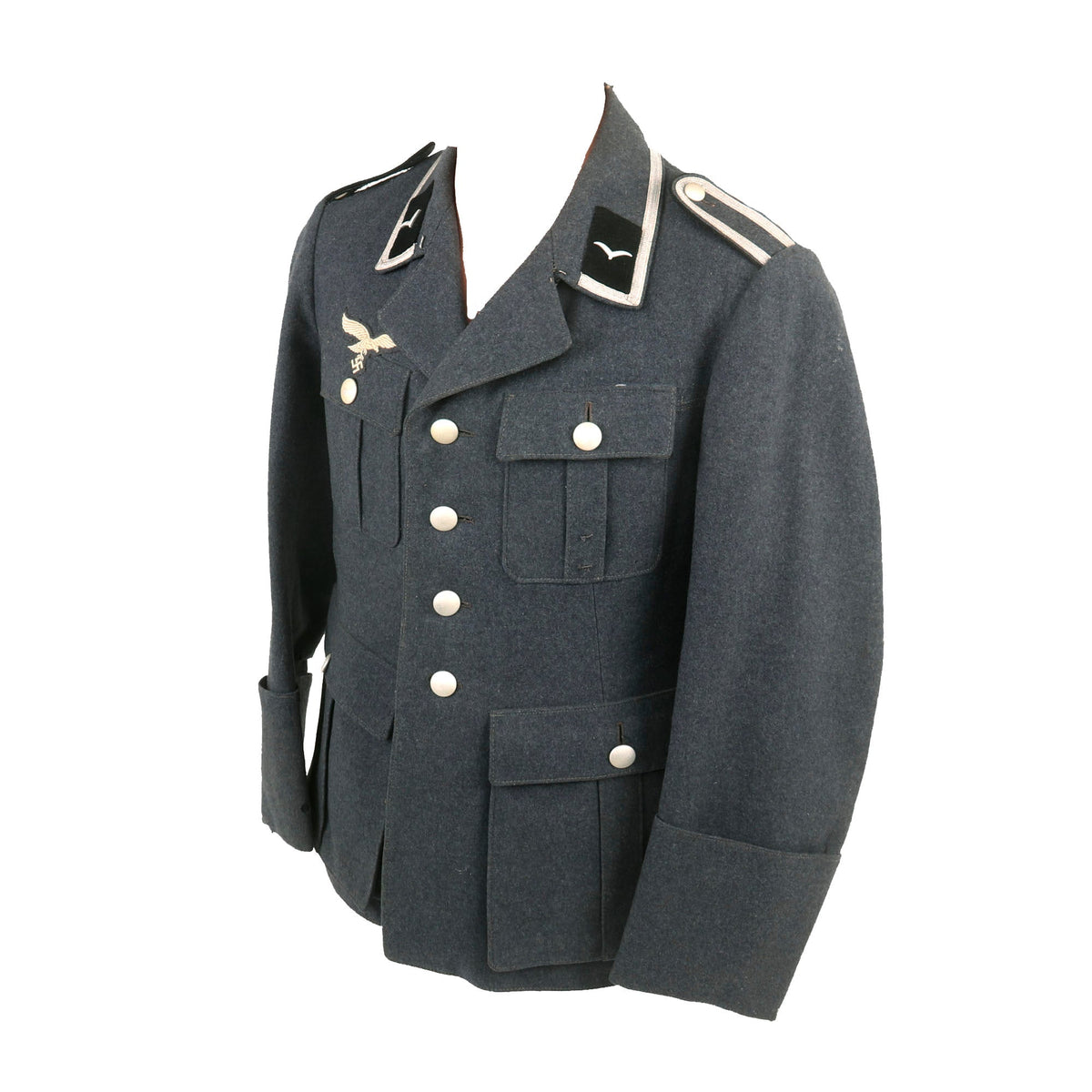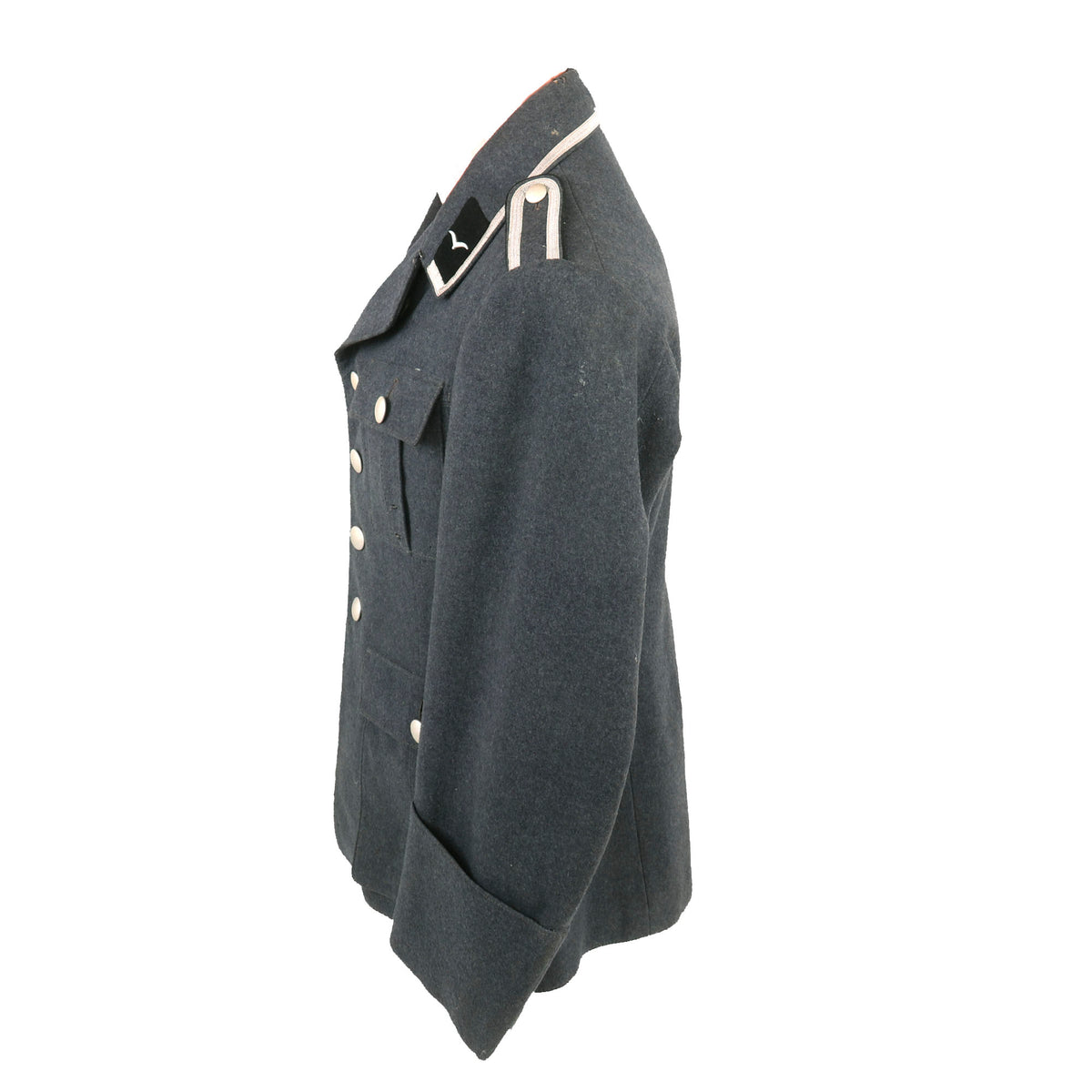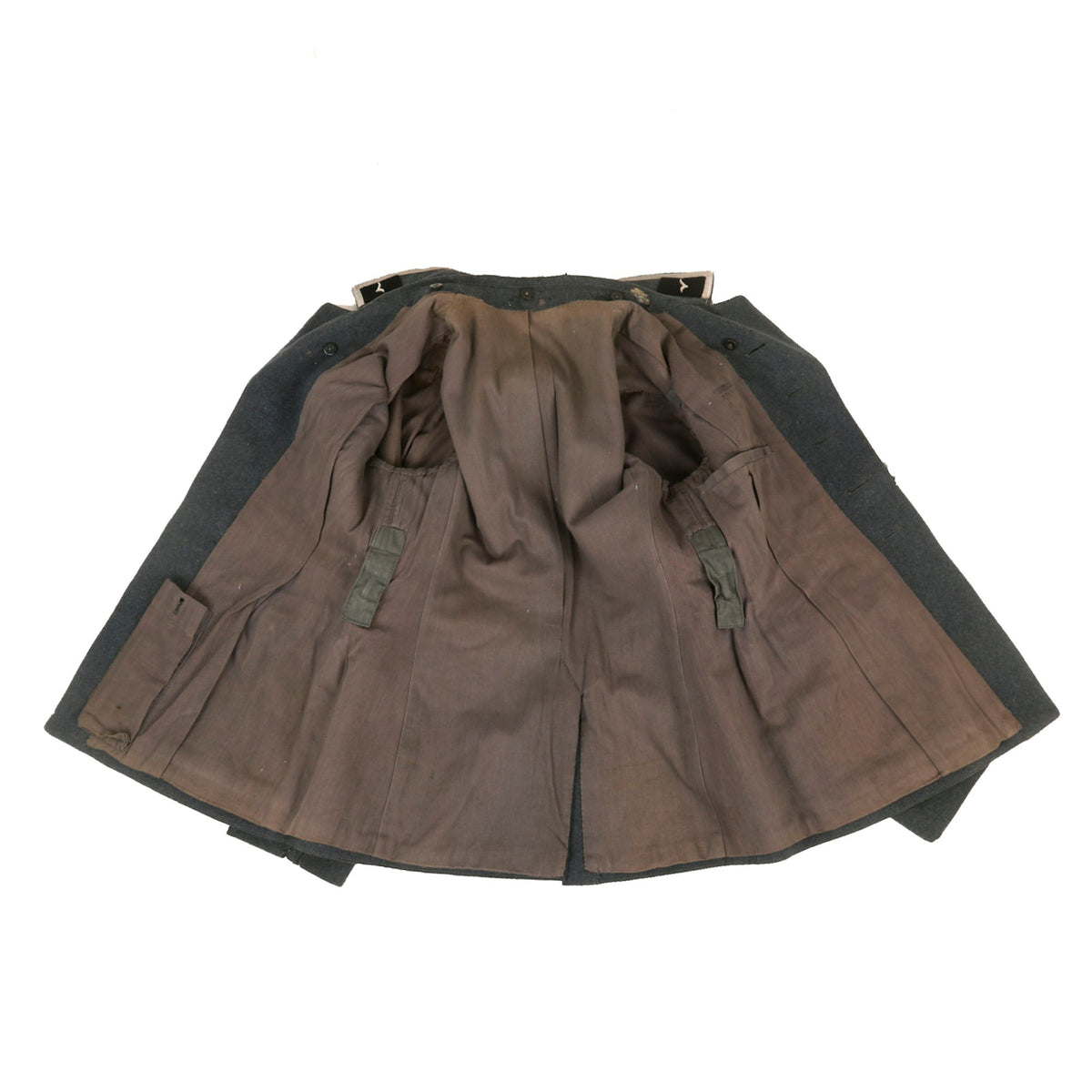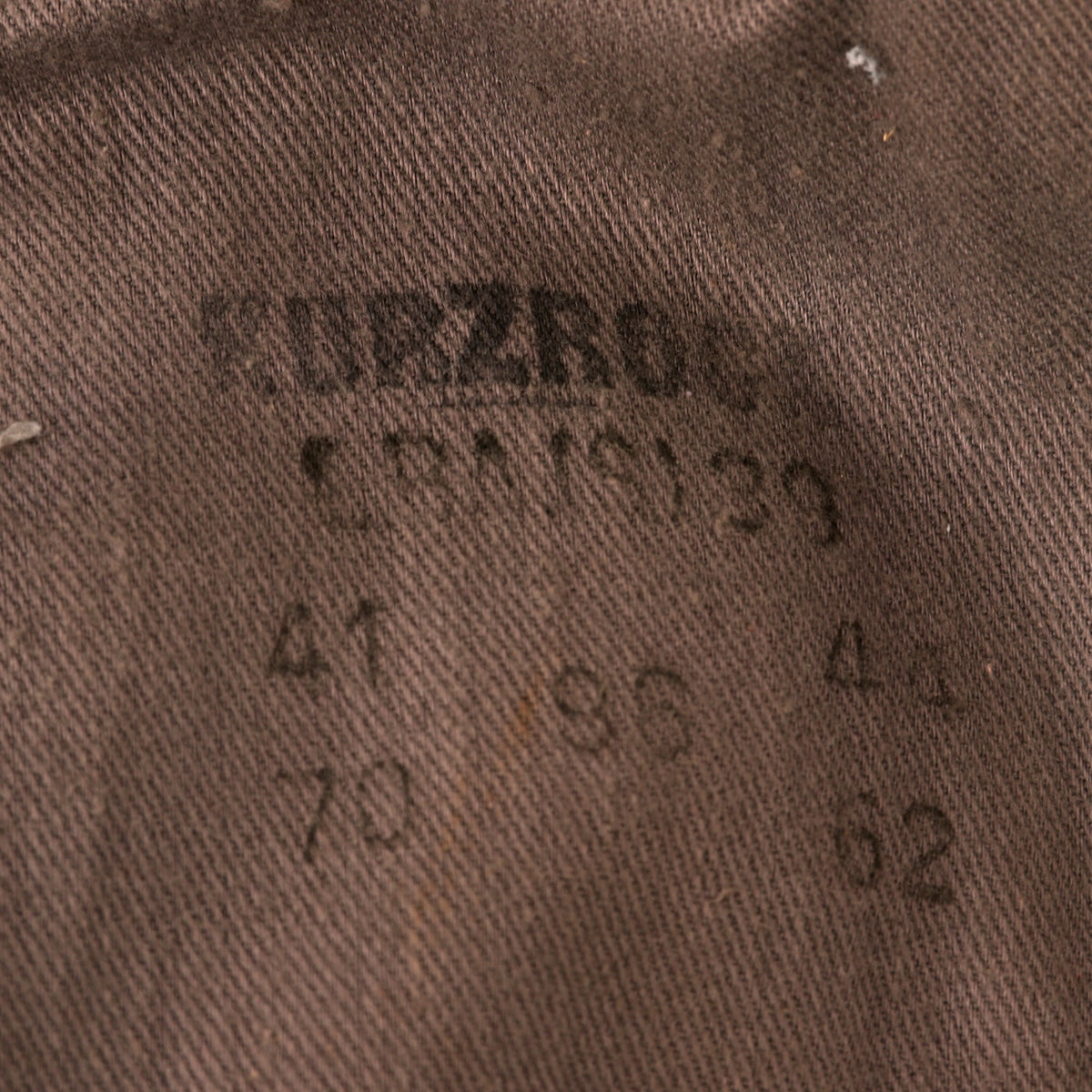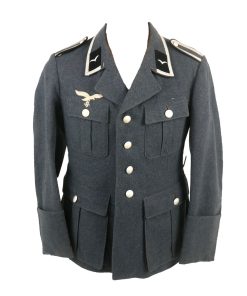Original German WWII Luftwaffe Engineer Corps Unteroffizier NCO Fliegerbluse Uniform Tunic – dated 1939 Original Items
$ 895,00 $ 223,75
Original Item: Only One Available. This is a very nice German WWII Luftwaffe Engineer Corps Unteroffiziere (NCO’s) Four Pocket Fliegerbluse (Flight Blouse) Service Tunic, made from lovely Luftwaffe Fliegerblau (Flyer’s Blue) Blue Gray wool. This example, like most enlisted and Junior NCO tunics, was depot issued, and is marked KURZROCK / L.B.A. (S) 39 on the interior left chest. This indicates it was inspected at the Luftwaffebekleidungsamt (Air Force Clothing Office) in Sonneberg, Germany in 1939. This marking is only seen on pre and early war Luftwaffe items.
The fliegerbluse tunic features a four button front closure with a hook and loop closure at the color, and it has four squared pockets with square button-down flaps. The pebbled buttons on the tunic are all non-magnetic, most likely made entirely of aluminum. They have some number markings on the reverse, but no definitive maker marking, and are stitched directly to the uniform fabric. The right breast of the uniform has a correct embroidered NCO Luftwaffe eagle sewn in place with the correct stitching pattern. It is only stitched to the outer layer of fabric, so it is the original eagle installed on this uniform tunic.
The collar of this tunic has 10mm wide NCO Tresse flat silver piping going around the entire collar, correct for an NCO fliegerbluse. The attached Kragenpatten (Collar Flaps) are in Schwarz (Black), the correct Waffenfarbe (Corps Color) for the Baupioniere (Construction engineer corps) and Luftwaffen-Pioniere (Air force engineer corps). The sew-in style Schulterklappen (Shoulder Boards or Epaulettes) have the same color piping, and a single row of 10mm NCO tress around the outside that is open at the ends without any rank “pips”. This indicates the junior NCO rank of Unteroffizier (Sergeant), which is confirmed by the collar insignia, which each show a single aluminum “gull wing” insignia.
The interior of the tunic is lined with blue gray light canvas around the body and in the sleeves, which shows only light wear. There are the previously mentioned markings above the inner left chest pocket, which have the size markings underneath:
41 44
96
70 62
There looks to be another LBA stamp across the opening for the pocket. It has the aluminum belt clips installed on their canvas straps, and a bandage pocket on the lower right waist by the front closure.
Overall condition is very good for the most part, though the collar and particularly the back of the right sleeve have suffered moth damage, which is very common due to the wool construction. This more than anything is one reason why the number of original German WWII uniforms is always decreasing.
A very nice Luftwaffe Engineer Corps Tunic, well marked and ready to display!
The Luftwaffe, the air force of the German military during the Third Reich, was established in 1935. Over the next 10 years, Luftwaffe troops wore a huge variety of uniforms. Enlisted men generally wore uniforms issued from military depots. Most enlisted soldiers had wool trousers and a short jacket with two internal lower pockets, called a Fliegerbluse, as well as a dressier 4-pocket tunic, the Tuchrock. Officers wore the same general uniform styles, but as officers had to supply their own uniforms, they usually wore tailor made versions. There were also myriad varieties of specialized uniforms worn by certain units or in specific situations, from the tuxedo-style “gala” formal wear uniform of the pre-war period, to the plain coveralls worn by crews of anti-aircraft cannons. There were work uniforms, tropical and summer uniforms, and camouflage clothing for airborne troops and other Luftwaffe soldiers in ground combat. Flight crews had their own specialized gear, including leather jackets and warm, electrically heated suits. Most but not all Luftwaffe uniform jackets bore the Luftwaffe emblem of a flying eagle holding a swas.
Fast Shipping with Professional Packaging
Thanks to our longstanding association with UPS FedEx DHL, and other major international carriers, we are able to provide a range of shipping options. Our warehouse staff is expertly trained and will wrap your products according to our exact and precise specifications. Prior to shipping, your goods will be thoroughly examined and securely secured. We ship to thousands clients each day across multiple countries. This shows how we're dedicated to be the largest retailer on the internet. Warehouses and distribution centres can be located throughout Europe as well as the USA.
Note: Orders with more than one item will be assigned a processing date depending on the item.
Before shipping before shipping, we'll conduct a thorough inspection of the items you have ordered. Today, the majority of orders will be delivered within 48 hours. The delivery time will be between 3-7 days.
Returns
The stock is dynamic and we cannot completely manage it because multiple stakeholders are involved, including our factory and warehouse. So the actual stock may alter at any time. It's possible that you may not receive your order once the order has been made.
Our policy is valid for a period of 30 days. If you don't receive the product within 30 days, we are not able to issue a refund or an exchange.
You can only return an item if it is unused and in the same state as the day you received it. You must have the item in its original packaging.
Related products
Uncategorized
Uncategorized
Uncategorized
Uncategorized
Uncategorized
Band of Brothers ORIGINAL GERMAN WWII Le. F.H. 18 10.5cm ARTILLERY PIECE Original Items
Uncategorized
Uncategorized
Uncategorized
Uncategorized
Armored Burgonet Helmet & Polearm from Scottish Castle Leith Hall Circa 1700 Original Items
Uncategorized
Uncategorized
Uncategorized
Australian WWII Owen MK1 Machine Carbine SMG Custom Fabricated Replica with Sling Original Items
Uncategorized
Uncategorized
Uncategorized
Uncategorized
Uncategorized

